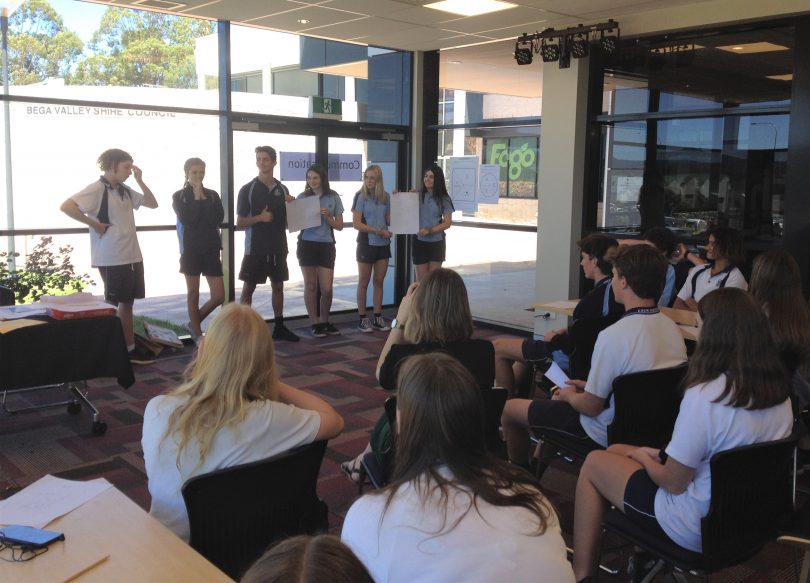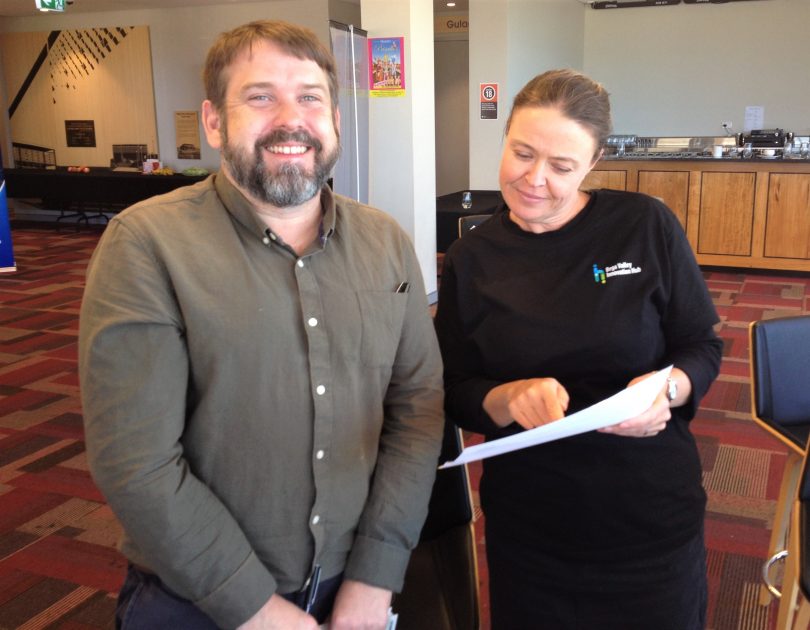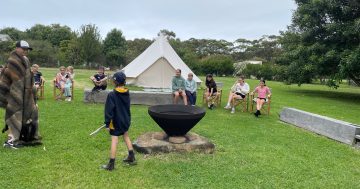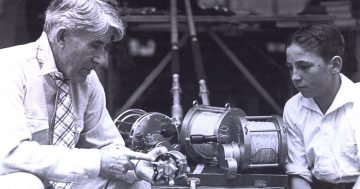
One of the groups from yesterday’s pitch session, hosted by Bega Valley Innovation Hub. Photo: Elka Wood.
The problem: Marley, from Wolumla, is 15 and wants to go to Merimbula to meet friends and go shopping. She’s finding it hard to get lifts, she can’t quite drive on her own and the bus service is infrequent.
What can the community do to help Marley out?
This week, almost 200 Year 10 students from Bega High School, Eden Marine High School and Lumen Christi Catholic College gathered at the Bega Commemorative Civic Centre to use creative problem solving and critical thinking techniques to brainstorm solutions for Marley’s transportation problems and other real-world problems the students came up with themselves.
The event was hosted by the University of Wollongong’s (UoW) Bega Valley Innovation Hub and delivered by Zach Sequoia of Launch Factory, along with facilitators from the Innovation Hub, Launch Factory, Headspace, Bega Valley Shire Council, UoW, 2pi Software and TAFE Bega.
The three issues the students chose to tackle were:
- How could we improve transportation options for youth in the Bega Valley Shire and can this be done in a planet-friendly way?
- How might we improve awareness of vacant jobs, social and sporting events, and available services (eg: transport, mental health) for youth within the Bega Valley Shire?
- How can we create and grow opportunities for cross-school events within the Bega Valley Shire?
Zach adjusted the same methods he uses with big business and government to take the students through the process of identifying the problems, coming up with creative solutions and pitching their ideas to each other.

Students pitch their ideas to each other at yesterday’s event, hosted by the University of Wollongong’s Innovation Hub Bega. Photo: Elka Wood.
“This [working with high school students] is something I’ve been wanting to do since the Innovation Hub first began,” Zach shares.
“I think this is the first time the methodology has been used in a regional high school setting, so it’s very exciting. Our hope is that if we start at high school age, in five years, some of these students will be inspired to continue their problem solving through the Innovation Hub.”
Lauren King is a Year 10 at Lumen Christi Cathol in Pambula and her group is answering the question about how to increase employment opportunities for teens in the Bega Valley.
“We don’t really know when jobs are available,” explains Lauren “because most advertising methods are not relevant to our age group – things like physical ads, newspaper ads and social media like Facebook.”
Lauren’s group identified that the way teens were most likely to look for jobs is via an app on their phones and so pitched the creation of such an app.

Eden Marine High School teacher James Ferguson and University of Wollongong Bega Campus Manager Sam Avitaia hard at work judging pitches. Photo: Elka Wood.
But facilitator Leigh Louey-Gung, founder of The History Cooperative, is keen to point out that not all the solutions students came up with were technology-based.
“We can say that this next generation is purely technology-focused but it’s always surprising to see what they come up with, one group has pitched a very face-to-face solution to the employment problem – basically, a job fair or expo.”
Leigh is clearly excited to be part of the pitch session, running from one group to another, keeping time and encouraging the students enthusiastically.
“I love this stuff,” he admits “I’d love to rewrite the school curriculum so that students have more of this – where it’s not abstract, theoretical learning but learning from their own lives and experiences – in my experience, so much more information is retained that way.”
Other ideas from the day included:
- Making electric bikes available via solar-powered E-Bike stations in and around our small towns with a pay per km and refundable deposit.
- E-POOL – a suite of electric cars in towns around the valley providing an app-driven car-pooling service with employment available as drivers for the unemployed and retirees.
- A podcast by and for local youth played at school rollcall – Schools take turns across the year to produce and record the podcasts and local organisations can send in items/events to be included.
- A virtual classroom set up in all local high schools where students can connect with students in real-time from other schools. Play music, talk and discuss issues, share stories and collaborate.
- A ‘Kids Shed’ or central meeting place for students was also recommended by a number of groups.
More photos from the day…

How might we improve awareness of vacant jobs, social and sporting events, and available services (eg: transport, mental health) for youth within the Bega Valley Shire? Photo: Supplied.

How might we improve transportation options for youth in the Bega Valley Shire and can this be done in a planet-friendly way? Photo: Supplied.

How might we create and grow opportunities for cross-school events within the Bega Valley Shire? Photo: Supplied.









